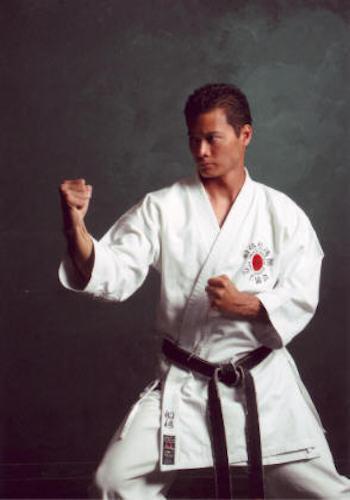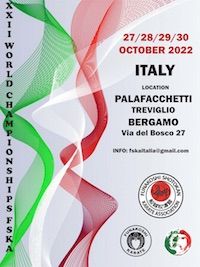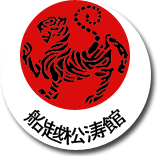 KYLE FUNAKOSHI
KYLE FUNAKOSHI
Funakoshi Shotokan Karate Association
An interview that has been somewhat ongoing for three years or so, this interview was finally completed in mid 2009. Kyle Funakoshi, son of world famous Kenneth Funakoshi, is a senior figure in the Funakoshi Shotokan Karate Association.
Throughout this interview, we learn about Kyle’s long karate history under his father and Chief Instructor of FSKA. Sharing memories and stories of his training history we explore more than just the Sensei and student relationship, but also the father and son relationship and their connection. We learn of Kyle’s approach to kumite, his training under a wide array of JKA instructors and about his life as a karate instructor. – Shaun Banfield 2009
Questions and conducted by THE SHOTOKAN WAY
(Shaun Banfield) Without sounding like a stupid question, can you please start by telling us about your introduction into karate and why you wanted to start?
(Kyle Funakoshi) My first introduction was watching my Father teach class in the early 70s. I began formal training in 1978. Being karate a family tradition, I had no choice, but was rather brought to the dojo to train.
(SB) Would you have naturally elevated towards the Martial Arts had you not been the son of Shihan Funakoshi?
(KF) Not sure. One thing for sure is if it hadn’t been for my Father, then I wouldn’t have stuck it out this long.
(SB) Can you please tell us about the training of your youth under your father to give us an impression of what it was like?
(KF) Training was very strict and traditional, and naturally, the expectations were higher. Correct and precise basics were emphasized. The advanced class was exhausting, and the Saturday classes had kumite sessions that went overtime frequently.
(SB) How did Shihan Funakoshi draw the line between being your father and your Sensei? Was there any difficulty in differentiating between the two roles?
(KF) Not really. I always had the same respect for him on and off the floor. And back then, the classes were very strict, so rarely did anyone get out of hand. If they did, they would feel the shinai stinging their leg.
(SB) Was he a strict instructor?
(KF) Yes, he had to be to maintain structure within the dojo. So many factors such as kids, adults and parents, to name a few. 100% effort was always expected, so it was difficult to slack off in class. When he wasn’t present, people were more casual, but once he stepped in, they knew it was business and had to be on their best behavior.
(SB) Do you have any fond memories/stories of your training under your father that you could share with us to give us a greater insight into your experiences?
(KF) Back in those days, dojo kumite was always fun to watch. I remember him playing with the higher ranks as if they were kids. Since his gyaku-zuki was fast and disabling, I’d try to test myself as an observer and guess when the attack would come. I also got a kick and smiled when he used to sting the higher ranks with a mawashi-geri and mae geris to the back. If it weren’t for being impressed with his kumite, then I wouldn’t have had the desire to train.
(SB) During your early training years, whist still with the JKA, did you have experiences with many visiting instructors? Can you please tell us about them and the training you experienced?
(KF) Yes, many Senseis came. Some of them were Nakayama, Asai, Kanazawa, Tanaka Isaka, Imura, Akiyama, and Kanai.
Tanaka Sensei was very serious on the floor, but was surprisingly friendly off the floor. Tanaka Sensei explained kata and had very good kicks.
Akiyama Sensei was a bigger Japanese person, so he had strong sweeping techniques but still had excellent control as he demonstrated oizuki at full speed to a student’s nose.
Kanai Sensei (Akiyama sensei’s student) had a yoko-geri that was very fluid and powerful like a whip.
Asai Sensei was unique because of his flexibility and fluid techniques. He had very fast snapping techniques that would hit a person multiple times in a second.
(SB) You were FSKA Kata and Kumite Champion. Do you have any memorable fights that you would like to discuss with us? Anything that stands out in your mind?
(KF) Going way back on some of these, but I’d say Akira Fukuda for his quick gyaku-zuki, Glenn West for his theatrics, Keoki Suerth for his excellent yori ashi and timing, Henry and Anthony Larkin for their reminiscent old school pressing style, and Kevin Warner for his spirited punching and kicking combos.
Although tournament competition is essential to one’s training, and being able to experience victory, I have always been taught to use this as an ego deflator. This way, no matter what achievements you attain, you are always grounded and able to relate to people of all levels.
(SB) Are you of the belief therefore that competition should be simply another method of training rather than a goal or objective?
(KF) Absolutely, because competition is just a portion of your training. If winning was my ultimate goal, then I would’ve quit a long time ago. However, realizing that there is more to karate-do than winning, I am still learning about myself, which is enlightenment.
(SB) And as a fighter, did you adopt more of an aggressive offensive approach or a defensive approach?
(KF) Offensive. If the distance was right, then I’ll go straight in and attack with whatever is easiest. However, if the distance wasn’t within range, then I’d have to create the opening, whether it be by feinting, misdirection of technique, drawing opponents closer, etc.
(SB) Competitively, which did you enjoy the most and find most exciting?
(KF) As important Kata is to one’s training to learn about body movement and control, I found it quite boring. Kumite was always fun and glorious, being the driving factor for my training.
(SB) And have you ever been interested in WKF competition?
(KF) No. Although WKF competition fills a section of the sporting aspect, it’s not in my interest. The concept and rules have changed the feeling and techniques that are executed. However, some competitors, mainly from Japan still retain the budo behavior (maintaining composure, and not overacting) while competing in WKF tournaments. I hope they retain this feeling and that it spreads among the other participants.
(SB) From my research so many people comment on how great your technique is. What would you say are the secrets behind having sound and effective basics?
(KF) The secret is to learn the basics correctly and slowly to not develop bad habits. Usually, the beginner (and many black belts) have too much tension in their upper bodies , which leads to inefficiency. One could practice the basics slowly, as if doing Tai Chi, to properly learn the coordination and linkage of body movement. Then, after the form is perfected, the fluidity of speed and power will produce kime. To properly execute kime, at the end, one must be relaxed from the beginning.
(SB) In your own students, and from your teaching, how do you go about helping students lose this tension?
(KF) I have them practice the techniques very slowly without kime. As if they were white belts all over again. Then, once the correct form is obtained, then the speed can be increased. Also, camcorders are another tool to have a visual impact that will last longer. . As if one were looking from the outside in. However, if one is resistant because there is an extreme amount of tension, then doing kihon or kata repetitively to exhaust them is recommended. After exhaustion, then they can focus on the corrections because they are too tired to do it incorrectly at full speed and power.
This is why it’s important to have students learn the basics correctly, because it’s so much easier to build upon a blank pallet, rather than trying to erase and reprogram someone whose mistakes are engrained.
(SB) You are quite a young man, but very experienced. Why did you decide to make karate your way of life?
(KF) The dojo has always been my second home, so it has always been a part of my life, therefore no decision had to be made.
(SB) And has teaching given you a fulfilling life so far, and where do you see your personal teaching future heading?
(KF) Definitely. Because of Karate, I have met people from all walks of life. There would be no way that I would be able to chat after class with a Doctor, plumber, school teacher, engineer, salesman, and a NASA scientist all at the same time. Since I interact with many of my students, I’ve also learned many life lessons from them, which serve as a precaution when making personal decisions of my own. Also, traveling has led me to experience many cultures around the world, enabling me to reassure my own beliefs, or to introduce innovation, and make me think “aaaah, that makes sense!”
(SB) What do you think are the most important elements of Karate-Do to emphasize both technically and philosophically?
(KF) It would have to be humility and dedication. If one is humble and sincere about karate-do, then there will be a mental and physical balance. If there is an imbalance, then one’s ego will get in the way, and lead to insecurity, regardless of skill level.
(SB) You have travel the world teaching within FSKA. How would you say the standard of students differ over the different continents you teach at?
(KF) I’d say the Eastern European countries and France are skilled and have proper feeling in kumite. Mexico has lots of potential, also. However, no matter how skilled a country is in kumite, there is always more room for kata improvement. Learning internal kime stemming from one’s legs and stomach will bring back the proper feeling, instead of just using elbow and knee snap, commonly found in sport karate competition. Elbow and knee snap should be incorporated, but it is the end result, not the starting point of techniques.
(SB) So you think too many don’t use their hara or centre enough? How do you help such students to develop this?
(KF) Again, perfection through repetition is the key. Do it slowly and think of the hara being the origin, then the kime will spread from there. Also, the hara is the origin of kime, however, the feet (gripping of toes and foot positioning) are the base, which allow the kime to spread to the limbs.
(SB) What are the most important principles of FSKA that you stress most in your classes?
(KF) Respect is earned, not demanded. If you don’t have respect for your lower ranks, then they will not respect you as a person. For them to truly respect and want to learn from you, then treat them with the same amount of respect as if they were your sempai or sensei. After all, instructors are constantly learning by teaching; so in a sense, the students are our senseis in an experimental form.
(SB) Is it important therefore for karate to still be a voyage of discovery for you?
(KF) Yes, I’m constantly learning by training and teaching. Being able to relate/interpret the corrections to students is fulfilling. Also, learning about people’s character by dealing with students/instructors worldwide is a mental stimulant.
(SB) We have seen photographs of Sensei Funakoshi teaching an exercise involving a belt, which he holds the tips of, while the student holds onto the center of the belt and punches. Can you please settle my mind and explain what its purpose is and how this exercise should be practiced?
(KF) This is to develop the proper coordination of muscles and joints to execute a proper gyaku zuki. Many people incorrectly begin with tension in their upper body to begin a basic punch. However, with this exercise, one has to put their mind on their back leg to begin the punch, which turns the hips, which allows the hand to ride the hip, delivering the punch in an efficient and explosive way.
(SB) Are there any other excellent training exercises like this that you use in your classes that you would care to talk about for fellow instructors to possibly use in their classes?
(KF) Yes, there are many exercise and examples to effectively relate the proper feeling for any technique. The exercises are better explained in person. However a quick example to relate karate to everyday movement ~, many people drag their back leg when recoiling into a kamae stance. To convey the proper feeling, I tell people to think of it as walking, where you use your muscles to pull the leg. One does not drag their feet while walking (unless dreading to go to work).
(SB) Does your approach differ at all would you say to your father’s?
(KF) Naturally, everyone develops their own style to convey corrections relative to students, young and old.
(SB) What is Kyle Funakoshi’s favourite kata and why?
(KF) Presently, none. I try to practice along with all groups and shadow the students who are learning their exam katas, so they can learn effectively without putting additional pressure on them having to memorize steps, but rather to perform it correctly by following.
(SB) At this moment in time, what line of research are you currently following in your personal karate?
(KF) Through training, one naturally experiences injury whether it’s from competition, practice, or any repetitive movement. Whether or not one chooses to live with the injury and it’s long-term effects is another story. I prefer living without pain, so this has led me to an interest in bodywork (visceral manipulation, trigger point therapy, and chiropractic). If one finds a proper bodywork program, the benefits of being structurally correct are amazing. Also, certain types of stretching are incorporated and tailored according to one’s needs.
(SB) Could you please elaborate on this and give us a deeper insight as to how your training has therefore changed due to this understanding of the body?
(KF) Having seen the long-term effects of old school training, my personal training regimen has changed dramatically. After an injury or hard training, I’ve learned to work on myself if possible by equipments such as a professional thumper, neck cradles, back cradles, theracanes, etc. If there is a serious nerve interference, then adjustments by a legitimate professional is recommended. Also, one must examine proper hip rotation, foot and upper body positioning while executing techniques to avoid deterioration commonly found with the hip and knee joints. Many stretches that were traditionally taught aren’t sufficient for most people. Knowing your body’s restrictions will enable you to focus on stretches that will target the area.
Incorporating stretches from Thai Massage, or yoga will benefit many people. And the order of stretches is important. For example, if one is tight in the hips, then stretching the hips before doing the splits will be more effective than vice versa. Again, the importance of learning the basics as a white belt goes a long way, because what you do in class now will affect your body years later.
(SB) Apart from Shihan Funakoshi, who else would you say has had a considerable influence on your understanding of Karate-Do?
(KF) Shihan Funakoshi provided the foundation and inspiration, especially watching him toy with the advanced students in kumite. My brother, Kevin, was also instrumental in my training since he, too, was an International kata and kumite champion. And being fortunate to experience Asai Sensei’s 6am training sessions provided a model of discipline to always strive further, regardless of age.
(SB) Could you tell us about this 6am training, I’d love to hear about it?
(KF) Asai Sensei was religious about his morning training. He had me do stances for long periods of time. Then,do speed exercises that made me learn about efficiency of body movement through exhaustion.
(SB) Final question, would you say having the surname ‘Funakoshi’ has hindered or benefited you at all in your karate training and in what ways?
(KF) Not sure, but I am asked what the relation is to Kenneth Funakoshi and Gichin Funakoshi. Shihan Kenneth Funakoshi is my Father, and Sensei Gichin Funakoshi is my cousin.
(SB) Is there anything I have neglected to ask that you would like to discuss with our readers?
(KF) None that I can think of, but just remember to train hard and be humble because everything can be taken away at any moment.
(SB) Can we just say a huge thank you for the opportunity to talk with you, and we wish you every success for the future.
(KF) Thank you for the opportunity.


